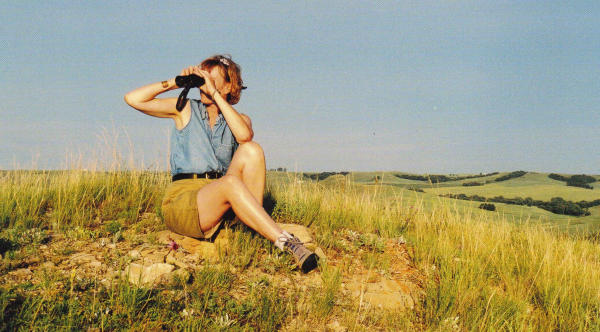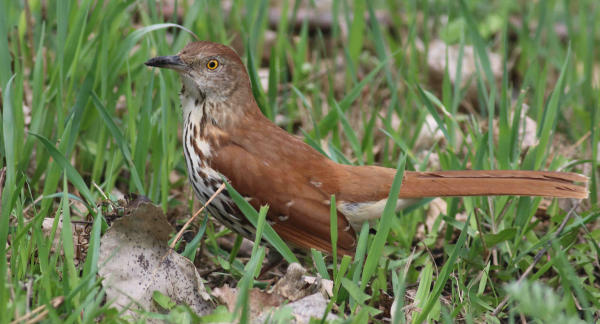

Brown Thrashers are secretive birds and the best singers in “The World.”
|
Last Friday, my dear friend Jennifer invited me to her ranch southwest of Bismarck where we enjoyed a fun evening relaxing at the edge of the Heart River breaks, one of the prettiest mixes of prairie hills carved by wooded coulees leading to the Heart River. When I was first introduced to this location as a college student, it was known as “The World,” a special place to visit in the wildlands of Dakota.
Jenny and I shared frosty Coronas on the lawn overlooking The World and talked of life and love and politics while identifying all the birds in her world. Jen knew all the species, and because we were west of the Missouri River, there were a number of the western species I don’t see 100 miles to the east. Such western birds as Spotted Towhees, Say’s Phoebes and Red-shafted Northern Flickers, along with favorites of Jennifer’s including Brown Thrashers, American Goldfinches, House Wrens, Lark Sparrows, Eastern Kingbirds, Mourning Doves, a couple migrating Red-eyed Vireos and a soaring Red-tailed Hawk. We watched a Common Nighthawk as it took flight repeatedly, and I was surprised to see it land in a tree, which is rare; well, actually unheard of, in my neighborhood. We even saw both east and west deer – White-tails and Mule Deer – with fawns.
It was a perfect summer evening with an occasional wisp of wind stirring the super-fresh air, clear blue sky and blissful solitude spiced by bird songs. Jennifer and I are generally more active – hiking cross the hills and coulees in search of wildlife over the next hill. But “stationary birding” was definitely the best way to absorb the peaceful excitement of that beautiful evening.
Birders have been enjoying stationary birding for – well, forever. Whether it’s on a porch or deck, or from an easy chair near a living room window, stationary birding is a part of our weekly birding lifestyles. Same during a recess to a family cabin or beach rental, stationary birding is part of any outing. Even at work, and especially from a breakroom window at the office or manufacturing plant or street-front business, sometimes it’s nice to take a break and see the birds go by . . . not all birding must be activity-based.
Of course, there are competitions for stationary birding, in the form of the “Great Birding Sit” in Texas during the Great Texas Birding Classic, the “Big Stay” during the World Series of Birding in New Jersey, and the “The Big Sit!,” which has been described as a “tailgate party for birders” that anyone anywhere in the world can participate in. In fact, all these events are designed for a birding team or individual birders to raise money for worthy nature sites and conservation groups.
The Great Birding Sit and Big Stay take place during May, while The Big Sit 2018 will take place on the day of your choice during the weekend of October 13 and 14, which is coming up sooner than you think. The Big Sit is an annual international non-competitive birding event hosted by Bird Watcher’s Digest and sponsored by Swarovski Optik. Founded by the New Haven (Connecticut) Bird Club, birders from around the globe unite by participating in this free event, open to any person or birding club in any country! There have already been Big Sit teams formed in England, the Netherlands, New Zealand, India, Vietnam and Guatemala. Will you be joining the fun? For more information, visit https://www.birdwatchersdigest.com/bwdsite/connect/bigsit.php,
The next time you visit a personal favorite “big relax” location, you may better appreciate how relaxing, if not therapeutic, birding can really become. At the same time, it may be exciting and inspiring, depending on the birds you see and the company you share.
Article and photographs by Paul Konrad
For more information, also check out https://tpwd.texas.gov/events/great-texas-birding-classic/tournament-categories-1/competitive-adults andhttp://worldseriesofbirding.org/uploads/2018_Ways_to_Participate.pdf